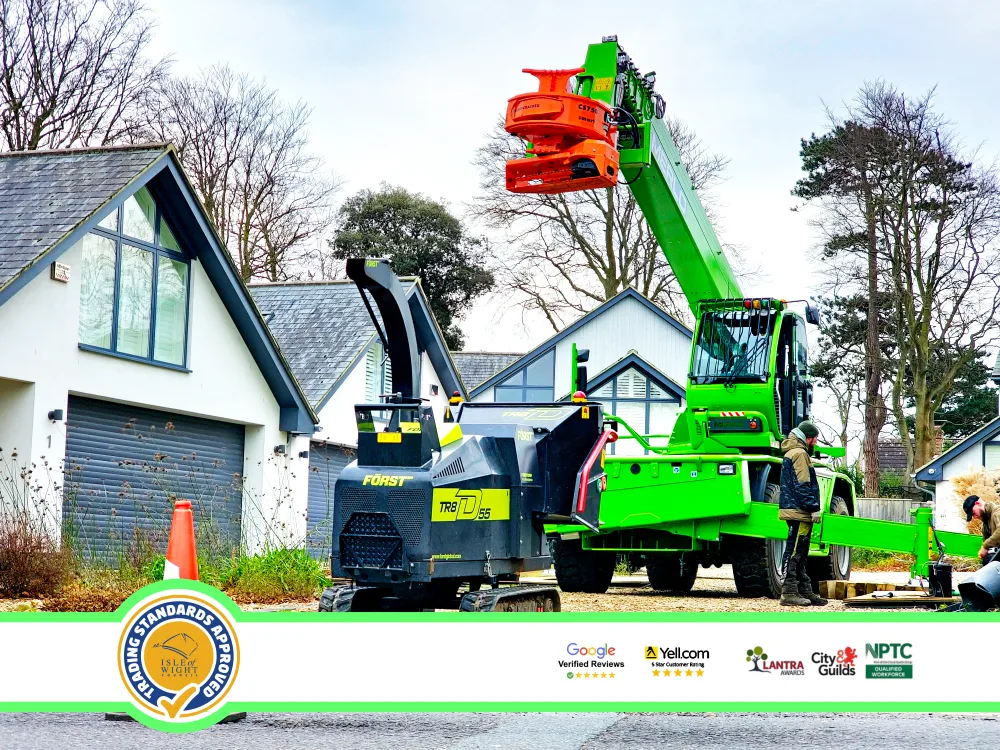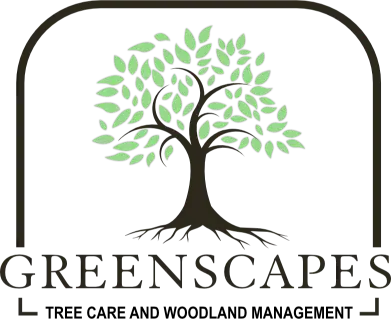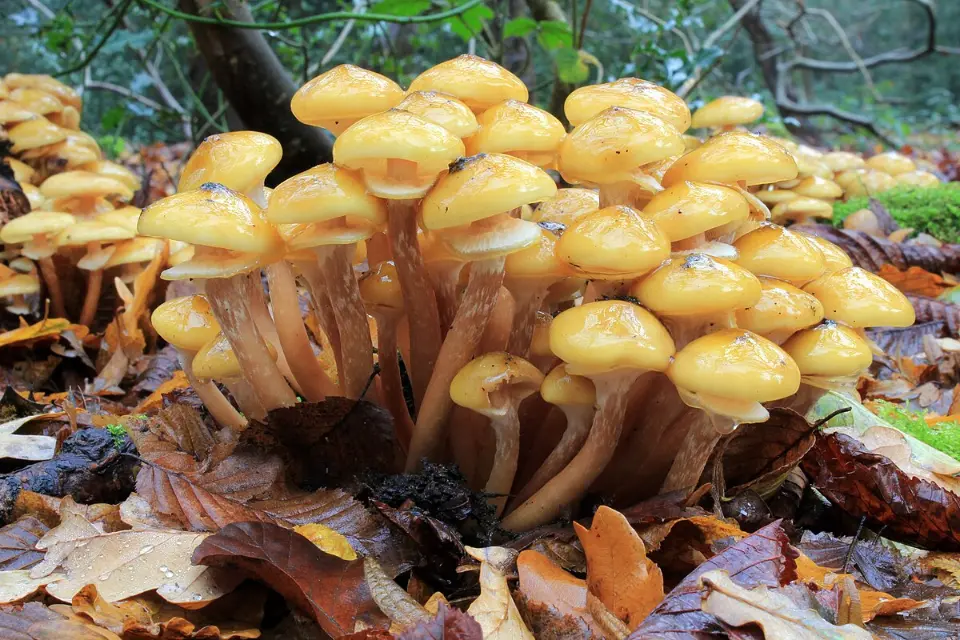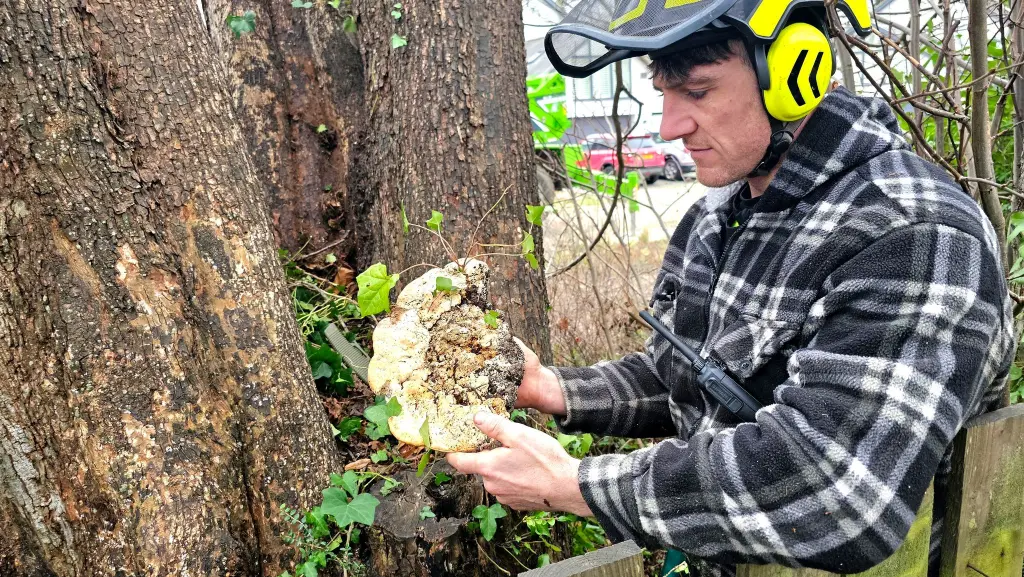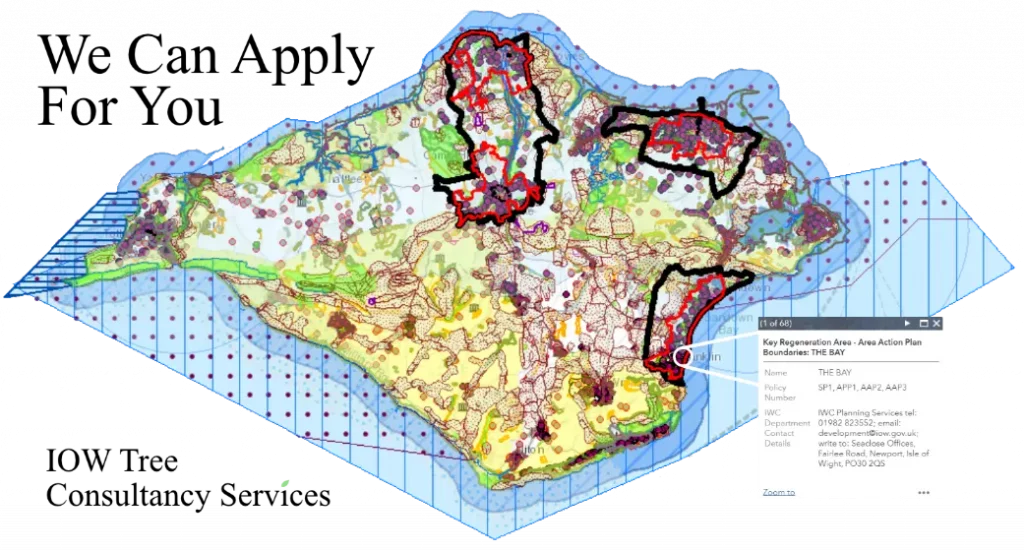DIAGNOSE tree health
How can I tell if my tree is healthy?
Tree health is best assessed by a trained professional, but here are a few key signs to look out for that may help you identify trees at risk.
Changes in trees’ appearance can often be a good indication that your tree may be becoming unhealthy. Signs like increased amounts of deadwood, leaf discolouration, crown thinning and dieback are all warning signs that something more significant may be going on and further investigation may be required.
These symptoms may be caused by fungal infections or diseases, improper pruning and decay, or root damage from soil compaction, landscaping, or building works. An expert can help you determine the cause of tree decline, its safety, and the best management solution.
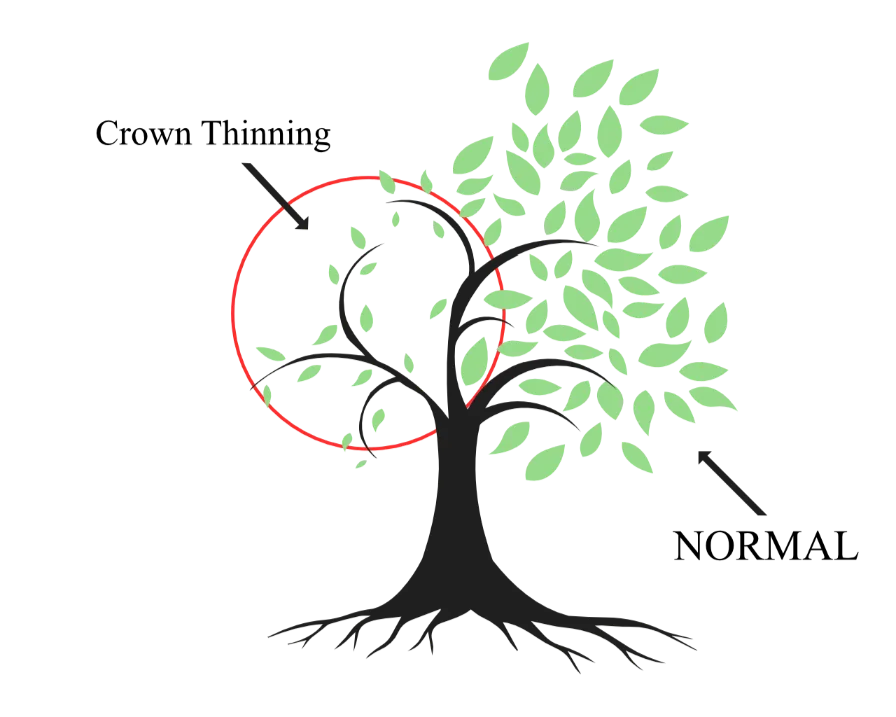
Crown dieback
Crown dieback refers to the condition where the upper canopy or crown of a tree begins to deteriorate. It is often an indication of underlying health issues within the tree. Here’s some more information:
As leaf loss occurs, deadwood protruding from the crown may be visible. This is a clear warning sign of illheath in your tree and if identified it is recommended you get a professional tree inspection at this point for further clarity of the risk and causes.
Large amounts of deadwood or entirely dead portions of the crown, known as a stag’s head, may become visible. At this stage of crown deterioration, the tree will likely be severely compromised but may still seem externally in reasonable shape to the untrained eye. Tress may still bear leaves in less affected portions of the canopy.
Trees showing these symptoms should be treated as a high risk of significant failure, and a call to your local tree specialist to arrange a tree health assessment is recommended.
Bark delamination usually occurs when tree vitality has become very low, which indicates an imminent failure is likely.
Crown dieback is commonly a symptom of fungal infection, root damage and ground compaction. These things will inhibit the tree’s ability to draw up sap and feed its extremities with the minerals, nutrients, and sugars crucial for growth, life and leaf production.
Certain fungal infections, such as Ganoderma, Armillaria, or Phytophthora, can attack the roots or trunk of the tree, leading to crown dieback.
Factors like drought, nutrient deficiencies, soil compaction, or air pollution can stress the tree, causing the crown to thin out.
Insect pests like borers or beetles can weaken the tree’s vascular system, affecting its ability to transport water and nutrients to the crown.
Injury to the trunk or branches, whether from mechanical damage, storms, or improper pruning, can also contribute to crown dieback.
The tree may shed leaves prematurely or exhibit sparse foliage in the upper canopy.
The density of foliage in the crown decreases, resulting in a thinner appearance.
Leaves may turn yellow, brown, or reddish, indicating stress or nutrient deficiencies.
Dead branches or twigs may be present within the crown, further reducing foliage density.
Professional arborists or tree specialists can conduct a thorough assessment of the tree’s health to diagnose the underlying cause of crown dieback. This may involve:
- Visual inspection of the tree’s canopy, trunk, and root system.
- Soil analysis to determine nutrient levels and soil compaction.
- Sampling of affected tissues for laboratory analysis to identify fungal pathogens or pest infestations.
- Assessment of environmental conditions and site history to understand potential stress factors.
Once the cause of crown dieback is identified, appropriate management strategies can be implemented. These may include:
- Pruning: Removal of dead or diseased branches to improve the tree’s structural integrity and promote new growth.
- Soil Amendments: Application of fertilisers or soil conditioners to improve soil health and nutrient availability.
- Pest and Disease Control: Treatment with fungicides, insecticides, or biological controls to manage fungal infections or pest infestations.
- Environmental Remediation: Addressing underlying environmental stressors, such as watering during drought periods or improving soil drainage.
Overall, early detection and intervention are crucial in managing crown dieback and preserving the health and vitality of trees. Regular monitoring and maintenance by trained professionals can help identify issues promptly and implement appropriate solutions.
Epicormic growth
Epicormic growth, known as water sprouts or basal shoots, occurs when a tree responds to stress, injury, or disturbance by producing new shoots or branches from its trunk, limbs, or roots. This growth can affect the tree’s health and structural integrity, leading to potential risks. Hiring a professional arborist to manage your trees will reduce stress caused by improper pruning, which is the most common reason for unhealthy regrowth.
Tree surgeons can accurately assess the extent of epicormic growth and determine whether it poses a risk to the tree or surrounding property.
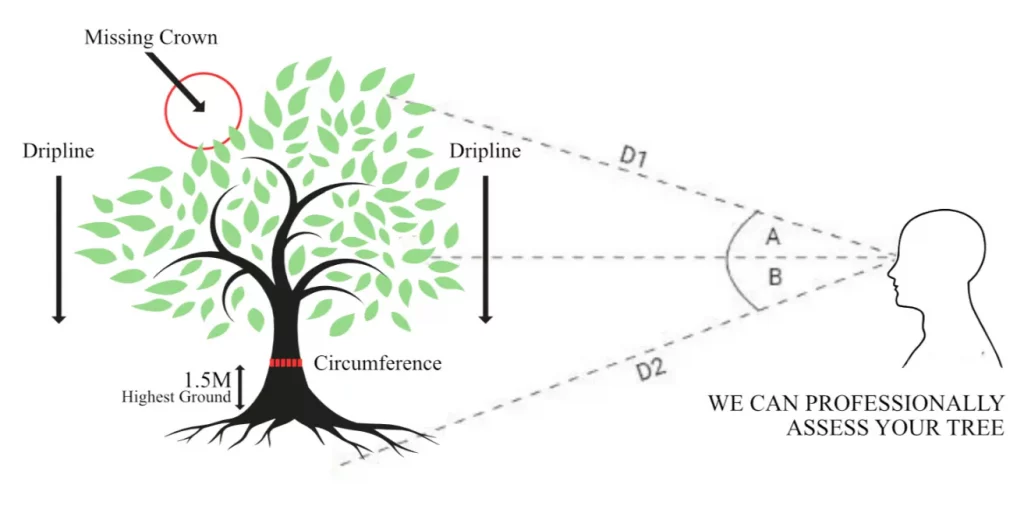
Tree surgeons have the expertise to identify and prune epicormic growth safely and effectively, promoting the tree’s longevity and reducing potential hazards.
By addressing epicormic growth promptly, tree surgeons help mitigate the risk of falling branches or structural failure, enhancing safety for people and property.
Tree surgeons can implement measures to preserve the tree’s overall health while managing epicormic growth, ensuring its longevity and aesthetic appeal for many years to come.
Hiring a qualified tree surgeon ensures compliance with British regulations and standards for tree care, ensuring the correct advice if given and professional tree maintenance is provided.
All our works are carried out respectfully in accordance with BS3998:2010 “Recommendations for Tree Work” or current industry “best practice” guidelines. All working practices comply with guidance and regulations issued by the Health & Safety Executive.
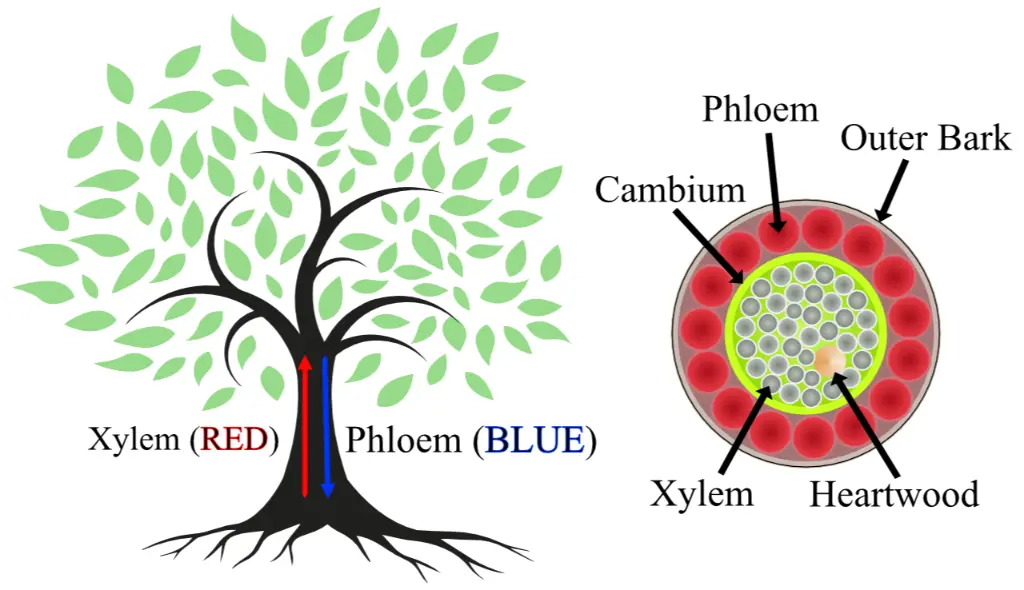
xylem phloem
The vascular system in plants, including trees, plays a vital role in transporting water, nutrients, and organic compounds throughout the organism. Here’s some information on the xylem and phloem:
(xylem phloem – The vascular system is comprised of two main types of tissue: the xylem and the phloem. The xylem distributes water and dissolved minerals upward through the plant, from the roots to the leaves. The phloem carries food downward from the leaves to the roots.)
The xylem is responsible for transporting water and dissolved minerals from the roots to the rest of the plant, including the leaves.
Xylem tissue is composed of specialized cells called tracheary elements, including tracheid’s and vessel elements. These cells are elongated, hollow structures that form interconnected tubes.
Water is absorbed by the roots from the soil and moves upward through the xylem vessels due to transpiration, a process where water evaporates from the leaves, creating a negative pressure that pulls water up through the plant.
Along with water, the xylem also transports essential minerals, such as nitrogen, phosphorus, and potassium, absorbed by the roots from the soil.
The phloem is responsible for transporting organic compounds, primarily sugars and other nutrients produced during photosynthesis, from the leaves to other parts of the plant, including the roots.
Phloem tissue consists of specialized cells called sieve tube elements and companion cells. These cells form long, interconnected tubes known as sieve tubes.
Sugars produced in the leaves through photosynthesis are transported downward through the phloem to areas of growth and storage, such as roots, stems, and developing fruits.
Unlike xylem, which transports water and minerals in one direction (upward), phloem allows for bidirectional flow, enabling the distribution of nutrients both upward and downward within the plant.
Xylem and phloem work together to maintain the overall health and growth of the plant. Water and minerals absorbed by the roots via the xylem provide the necessary hydration and nutrients for photosynthesis in the leaves. The sugars produced during photosynthesis are then transported through the phloem to other parts of the plant for growth, energy storage, and metabolic processes.
A healthy vascular system is essential for the overall health and vitality of trees. Any disruptions or damage to the xylem or phloem, such as from diseases, pests, or physical injury, can impair the tree’s ability to transport water, nutrients, and energy, leading to decline, dieback, or death.
Understanding the function and importance of the xylem and phloem in tree physiology can help arborists and tree care professionals diagnose and address issues related to vascular health and maintain trees.
Honey Fungus
Honey fungus (Armillaria) is a very common and highly transmissible fungus in the UK. It spreads underground, killing roots and causing sudden and dramatic failure in trees, causing them to fall suddenly or blow over once the roots are compromised. If identified, you should call a tree health expert IMMEDIATELY.
Honey fungus decays a tree’s root system, causing sudden and unexpected failure. With the tree’s root system decaying, the tree no longer has the ability to hold itself upright, resulting in complete and sudden failure as it loses stability and falls to the ground.
Honey fungus, scientifically known as Armillaria, is a type of parasitic fungus that primarily attacks the roots of trees and woody plants. It is known for its honey coloured mushrooms that often appear on the ground on the bases and in close proximity to infected trees.
Honey fungus colonises and decays the root system of its host plant, gradually weakening the tree’s structural stability and compromising its ability to uptake water and nutrients from the soil. The fungus forms mycelium, a network of thread like structures, around the root system, eventually leading to root rot and decay.
Trees affected by honey fungus may exhibit a range of symptoms, including reduced growth, yellowing or wilting foliage, dieback of branches, and the presence of fungal fruiting bodies (mushrooms) at the base of the tree.
Honey fungus can spread via underground rhizomorphs (root like structures) or through airborne spores released by the fruiting bodies. Once established in the soil, the fungus can persist for many years, infecting nearby trees and shrubs.
Tree braces, also known as support systems or tree props, are structural supports used to stabilise trees with weak or compromised trunks or branches. They are typically installed to prevent tree failure, particularly in urban or high traffic areas where falling limbs pose a safety hazard.
Tree braces are often constructed from metal rods, cables, or braces that are attached to the tree trunk or branches and anchored to the ground or nearby structures.
While tree braces can provide temporary support and prevent immediate failure, they can also have long-term consequences for tree health. Improperly installed or maintained braces can create wounds in the tree’s bark, providing entry points for pathogens, including decay fungi.
Over time, tree braces can promote internal decay and rot within the tree trunk or affected branches. Moisture accumulation around brace attachment points can create favourable conditions for fungal growth, leading to wood decay and structural weakness.
Proper installation and periodic inspection of tree braces are essential to minimise their negative impact on tree health. Regular monitoring by qualified arborists can help identify any signs of decay or structural compromise associated with tree braces and facilitate appropriate remedial action, such as brace removal or tree pruning.
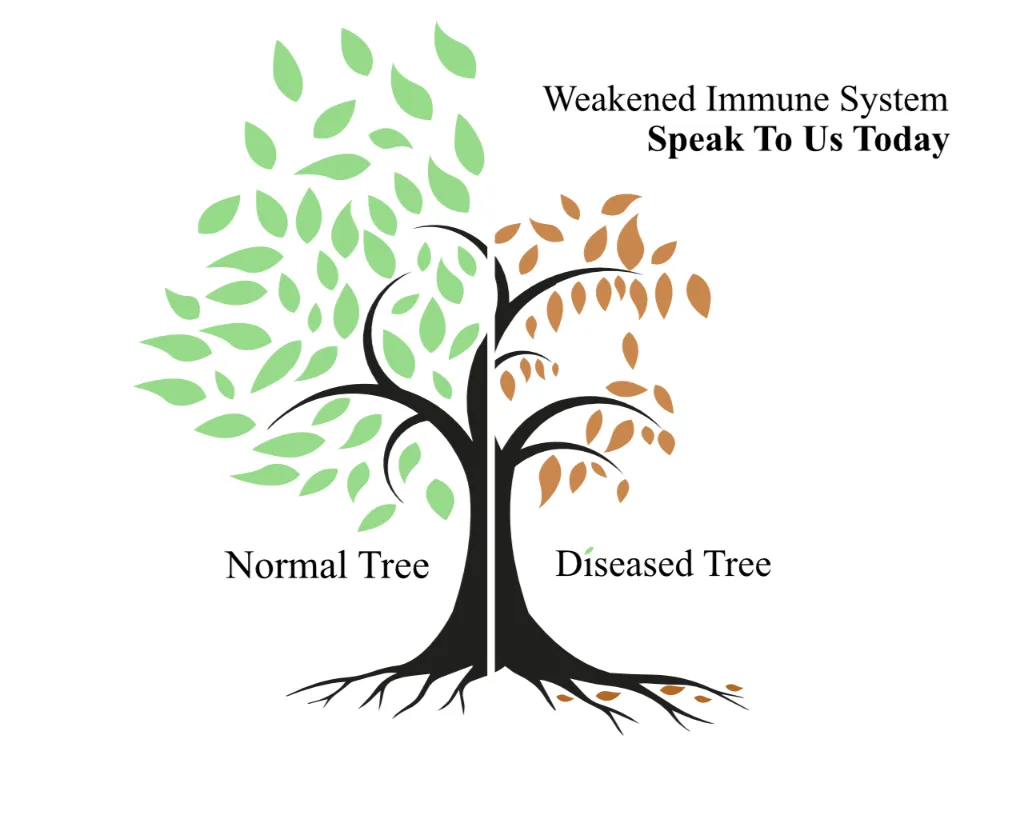
ASH DIEBACK
Ash Dieback, caused by the fungus Hymenoscyphus fraxineus, is a significant threat to ash trees across the UK. This fungal disease spreads rapidly and has been devastating ash populations since its emergence in the UK. Its main areas of damage are the South East of England, including the Isle of Wight. Here’s what you need to know about Ash Dieback:
Ash Dieback manifests in various symptoms, including leaf loss, crown dieback, and dark lesions on stems. Infected ash trees are considerably more brittle as they decline and pose a high risk of unexpected failure. If your tree exhibits any symptoms, call us for free tree inspection and management recommendations.
The disease progressively weakens the tree’s immune system, making it susceptible to secondary infections and structural failure. Ash trees affected by Ash Dieback are prone to branch breakage, canopy collapse, and eventual tree death. These trees are best managed with early intervention.
Ash Dieback spreads through airborne spores and can rapidly infect entire populations of ash trees.
Managing Ash Dieback requires careful removal if the trees are situated in a high-risk area. Greenscapes is the island’s leader in large and dangerous tree removal, using state-of-the-area machinery for unparalleled efficiency and safety. Check out our Merlo and Grapple saw page here for a more detailed call to arrange a viewing.
The loss of ash trees due to Ash Dieback has significant ecological consequences, affecting biodiversity, habitat structure, and ecosystem services provided by ash-dominated woodlands.
Rigidoporus
Rigidoporus, also known as Rigidoporus lignosus or brown root rot fungus can infect a wide range of tree species, including both hardwoods and softwoods. Common hosts include oak, beech, maple, and pine trees. Here’s an overview of Rigidoporus:
Rigidoporus typically infects the roots and lower trunk of trees, causing decay and structural weakness. The fungus produces distinctive brown rot, which can often be observed in the affected wood.
Rigidoporus can infect a wide range of tree species, including both hardwoods and softwoods. Common hosts include oak, beech, maple, and pine trees, among others.
Infected trees may exhibit various symptoms, including reduced growth, canopy dieback, and premature leaf drop. In advanced stages of infection, the tree’s roots and lower trunk may show signs of decay, with the presence of brown, stringy rot.
Rigidoporus spreads through spores produced by the fungus, which can be disseminated through air, water, or soil. The fungus can also spread through root grafts between adjacent trees, leading to the rapid colonization of entire stands.
Brown root rot caused by Rigidoporus can have significant economic and ecological impacts. Infected trees may become structurally unsound, posing hazards to property and people. Additionally, the loss of mature trees can disrupt forest ecosystems and reduce biodiversity.
Managing Rigidoporus infections often involves sanitation measures, such as removing and destroying infected trees to prevent further spread. Additionally, implementing cultural practices to improve tree vigour and resilience can help reduce susceptibility to infection.
Preventing the introduction and spread of Rigidoporus is key to mitigating its impact. This includes practicing good biosecurity measures, such as avoiding the movement of infected plant material and maintaining healthy tree populations.
Ongoing research into the biology and management of Rigidoporus is essential for developing effective control strategies. Increasing awareness among arborists, foresters, and the general public about the risks associated with Rigidoporus can also aid in early detection and intervention efforts.
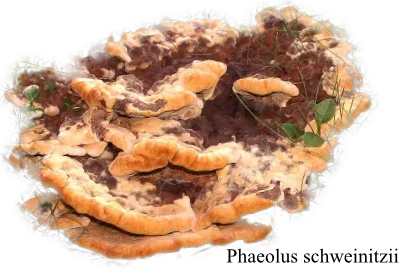
Dyers Polypore
Dyers polypore, also known as Phaeolus schweinitzii, is wood decaying fungus known in the UK for its dual role as a natural dyer and ecological steward. Lets break down the impact and how to identify Dyers Polypore in your garden:
Dyer’s polypore, a distinctive member of the fungal kingdom, can be identified through several key characteristics:
Stalked Brackets: Look for the presence of stalked brackets, or caps, emerging predominantly from the roots of conifer trees. These brackets often exhibit a circular to lobed shape, with individual specimens reaching sizes of up to 10 inches in width.
Variety in Colour: When young, the caps of dyer’s polypore may display hues ranging from cream and light red-brown to yellow or yellow-green. With age, these colours transition to darker shades, ranging from dark red-brown to deep brown, lending the fungus a distinct appearance at different stages of its growth cycle.
By familiarising oneself with these defining features, individuals can confidently identify dyer’s polypore amidst the diverse tapestry of woodland flora.
Dyer’s polypore, also known as tree bracket fungus, presents a formidable challenge when it comes to removal. Here’s what you should know:
Hardy Composition: Tree bracket fungus boasts a tough, woody body that makes it notoriously difficult to remove. In fact, its robust structure allows for the crafting of intricate artworks and jewellery, showcasing its durability.
Distinctive Appearance: Often referred to as shelf fungus due to its protruding growth from tree surfaces, dyer’s polypore stands out with its characteristic appearance. Unlike typical mushrooms, these fungi feature pores instead of gills for spore production, creating a unique and recognisable profile.
Age Indicators: The growth rings of dyer’s polypore provide valuable insights into its age and development. Each ring corresponds to a growing season, offering clues to its lifespan. As long as the host tree survives, the fungus continues to thrive, making its removal a complex endeavour.
Disease and Damage: Dyer’s polypore signifies an underlying disease within the tree’s heartwood, often resulting in structural damage and decay. While removal of infected branches can mitigate further spread, there is no definitive treatment for eliminating the fungus entirely.
Prevention Strategies: Prevention remains key in managing dyer’s polypore. Maintaining proper drainage to prevent damp conditions and promptly removing infected shelves can help limit spore dissemination and mitigate the risk of further infection.
Natural Defences: Healthy trees possess innate defences against fungal diseases, reinforcing the importance of maintaining tree vitality. Pruning damaged limbs cleanly and allowing natural healing processes to take place can aid in combating fungal infections.
While the presence of dyer’s polypore may pose challenges, understanding its characteristics and implementing proactive measures can contribute to effective management and preservation of tree health.
Effectively managing dyer’s polypore requires a comprehensive approach aimed at reducing its impact and preventing further spread. Here are key strategies to consider:
Early Detection: Regular inspections of trees for signs of dyer’s polypore growth are essential for early detection. Vigilance allows for prompt action to be taken before the fungus establishes extensive damage.
Pruning and Removal: Infected branches showing signs of dyer’s polypore should be promptly pruned and removed to prevent the spread of the fungus to healthy parts of the tree. Careful pruning techniques, such as making clean cuts and sterilising equipment between cuts, are crucial to minimise the risk of further infection.
Sanitation Measures: Proper disposal of infected plant material is essential to prevent the dispersal of spores and the contamination of surrounding areas. Thoroughly clean pruning tools and equipment after use to avoid inadvertently spreading the fungus to other trees.
Tree Health Maintenance: Maintaining overall tree health is vital in preventing susceptibility to dyer’s polypore and other diseases. Adequate watering, mulching, and fertilisation can help improve tree vigour and resilience to stressors.
Environmental Management: Creating a less favourable environment for dyer’s polypore growth can help mitigate its impact. Improving air circulation around trees, reducing moisture levels in the soil, and avoiding damage to tree roots can discourage fungal development.
Chemical Treatments: In some cases, fungicidal treatments may be considered as part of an integrated management approach. However, these should be used judiciously and in accordance with label instructions to minimise environmental impact and ensure effectiveness.
Professional Consultation: For severe infestations or complex situations, consulting with a certified arborist or tree care specialist is recommended. These professionals can provide expert assessment, diagnosis, and tailored management strategies based on the specific needs of the affected trees and the surrounding environment.
Planning Application Tree Survey and Report
If you’re planning a development project and trees are nearby, our qualified arboricultural consultants conduct BS 5837 tree surveys.
This British Standard outlines the data gathered during the survey, essential for development tree reports. Our surveyors help minimise tree impact to facilitate planning consent. Quality documentation is crucial for successful planning applications, and we provide samples of our Tree Data Schedule, Tree Constraints Plans, and Arboricultural Method Statements for your reference.
Tree Condition Survey and Report for Safety Management
Concerned about the health of trees under your care? Our tree surveys assess defects and diseases, recommending necessary works to mitigate risks. For further information, choose the Tree Condition Survey option from the menu.
Pre-Purchase Tree Survey and Report for Property Transactions
Considering buying or selling a property? Our pre purchase tree surveys evaluate subsidence risk and tree failure potential, covering all trees within influencing distance. We provide recommendations to manage risks effectively. For details, select the Pre Purchase Tree Survey from the menu.
Subsidence Management Tree Survey and Report
If subsidence issues have arisen, our surveys identify trees responsible for the problem and suggest risk reduction measures. For more information, choose the Subsidence Management option.
A: Warning signs include crown dieback, bark delamination, and signs of fungal infection such as bracket fungi. Crown dieback is usually easiest to identify when the tree is in full leaf, showing signs such as leaf loss, leaf thinning, and leaf discoloration.
A: Crown dieback refers to the deterioration of the upper canopy of a tree. It is often a symptom of fungal infection, root damage, or ground compaction, which inhibits the tree’s ability to draw up sap and vital nutrients. Signs may include deadwood protruding from the crown and a stag’s head appearance.
A: Landscaping or building works can damage tree roots, compromising the tree’s ability to sustain life. Heavy machinery used near tree roots can physically damage them, while root compaction from pathways or roads can restrict water and nutrient uptake.
A: Bracket fungi, such as Ganoderma bracket and beefsteak fungus, deteriorate the tree’s heartwood and weaken its structural integrity. They release wind-blown spores, affecting wounded wood and penetrating the heartwood, leading to rot pockets and further decay.
A: Trees affected by honey fungus may exhibit yellowing, wilting, or undersized leaves, dead branches, slower growth, and lower leaves than usual. This fungus decays the roots, causing structural instability and increased risk of tree failure.
A: Common signs include leaf discoloration, unusual leaf drop, dieback of branches, fungal growth on the trunk or around the base, and visible damage to the bark.
A: Look for symptoms such as mushroom growth at the base of the tree, conks (shelf-like structures) on the trunk, or visible decay in the wood. Fungal infections often manifest as discoloured or decaying wood, with a foul odour in advanced cases.
A: Contact a professional arborist immediately, as mushrooms can indicate a serious fungal infection that may compromise the tree’s structural integrity.
A: Signs of root rot include reduced growth, wilting foliage, and canopy dieback. Digging around the base of the tree to inspect the roots for discoloration, decay, or a foul smell can confirm the presence of root rot.
A: Bark damage can result from various factors, including mechanical injury from mowers or trimmers, pest infestation, fungal infections, or environmental stressors such as extreme weather conditions.
A: Hollow sections can develop naturally in older trees as a result of internal decay. While small hollows may not pose immediate risks, large or extensive hollows can compromise the tree’s structural stability and require assessment by a professional arborist.
A: Symptoms of water stress include wilting leaves, leaf scorch, premature leaf drop, and stunted growth. Inspecting the soil moisture levels and assessing drainage patterns around the tree can help diagnose water related issues.
A: Yes, certain pests and diseases, such as oak processionary moth (OPM) and horse chestnut leaf miner, target specific tree species commonly found in the UK. Identifying characteristic symptoms and conducting proper diagnosis are essential for effective management.
A: Practices such as regular watering, mulching, proper pruning, and timely removal of dead or diseased branches can help maintain tree health and resilience against pests and diseases.
A: It is advisable to consult a qualified arborist if you notice any concerning symptoms or changes in your tree’s health. Early intervention can prevent further damage and enhance the chances of successful tree recovery.
